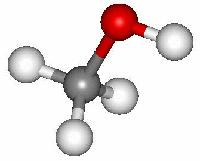|
The entry is based on a line list file provided by L.-H. Xu
from the review
(1) L.-H. Xu and F. J. Lovas,
1997, J. Phys. Chem. Ref. Data 26, 17.
Details on the RAM (RHO axis method)
and fitting program employed to reduce the data is available in
(2) L.-H. Xu, M. S. Walsh, and R. M. Lees,
1996, J. Mol. Spectrosc. 179, 269
and references therein.
These two papers also give details on the extensive data sets
considered in the fits. Because of the internal rotation (torsion),
torsion-rotation interaction, and large effects
of centrifugal distortion, global modeling of the
methanol spectrum is a challenging task.
Nevertheless, restricting the data set to vt = 0, 1,
Jmax = 20, and Kmax = 14,
the input data was reproduced within experimental uncertainties.
Very small experimental uncertainties have been set to 50 kHz
for most of the microwave lines in the fit.
Certain prediction, in particular those of higher J,
may be found outside three times the uncertainties.
However, because of the large body of transitions observed by
FTFIR spectroscopy, it is expected that these deviations are
within 6 MHz, an uncertainty value assigned to the FTFIR data).
Note: The current entry is
essentially identical to the first one, except that now intensities
at 300 K are available. In the absence of suffiently extensitive
energies in the catalog file or in a separate energy file,
partition function values were scaled from those of
the 18O isotopolog, see e034504.cat. Values scaled
from the main species differ only slightly. Please note also that
we employed here gI = 1, not 4 as for the main and
18O isotopologs. The quantum number format has been adjusted
to the spcat format, however, the quantum numbers were retained
(except that "a" signal a K value below –9.
The quantum numbers given are those of (1) and (2),
but slightly rearranged for lay-out reasons. They are
J, (sign)Ka, Kc,
(parity), immediately followed by vt.
The parities + and – refer to A+ and A – states;
while states with no parity designation refer to E symmetry.
A signed value of Ka is used to differentiate
(+)E1 from (–)E2 states.
It should be emphasized that E1 and E2
states belong to the same E symmetry species.
As usual, the energies in the catalog entry are given with respect to
the lowest rotational level (000 of the
vt = 0, A state) which is defined as zero.
The energies given in the documentation refer to the 000 rotational levels of the
vt = 0, A and E states and the
vt = 1, E and A states, respectively.
The dipole moment is assumed to be the same as for
the main isotopmer, see e032504.cat.
Note: The current entry takes
into account contributions of the permanent dipole moment
only ! Torsional or rotational dependences as well as
changes in the dipole moment with torsional state have not yet been
determined – or only to an insufficient amount. The effects of
these contributions may be non-negligible in certain instances.
|
